Chapter 10 Review Exercises
( \newcommand{\kernel}{\mathrm{null}\,}\)
Chapter Review Exercises
Finding Composite and Inverse Functions
In the following exercises, for each pair of functions, find
- (f∘g)(x)
- (g∘f)(x)
- (f⋅g)(x)
1. f(x)=7x−2 and g(x)=5x+1
2. f(x)=4x and g(x)=x2+3x
- Answer
-
2.
- 4x2+12x
- 16x2+12x
- 4x3+12x2
In the following exercises, evaluate the composition.
- For functions f(x)=3x2+2 and g(x)=4x−3, find
- (f∘g)(−3)
- (g∘f)(−2)
- (f∘f)(−1)
- For functions f(x)=2x3+5 and g(x)=3x2−7, find
- (f∘g)(−1)
- (g∘f)(−2)
- (g∘g)(1)
- Answer
-
2.
- −123
- 356
- 41
In the following exercises, for each set of ordered pairs, determine if it represents a function and if so, is the function one-to-one.
- {(−3,−5),(−2,−4),(−1,−3),(0,−2),(−1,−1),(−2,0),(−3,1)}
- {(−3,0),(−2,−2),(−1,0),(0,1),(1,2),(2,1),(3,−1)}
- {(−3,3),(−2,1),(−1,−1),(0,−3),(1,−5),(2,−4),(3,−2)}
- Answer
-
2. Function; not one-to-one
In the following exercises, determine whether each graph is the graph of a function and if so, is it one-to-one.
-
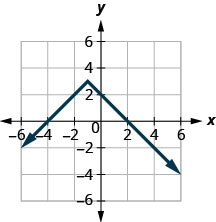
Figure 10.E.1
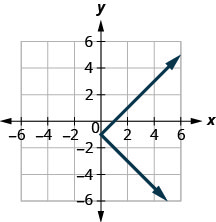
Figure 10.E.2
-
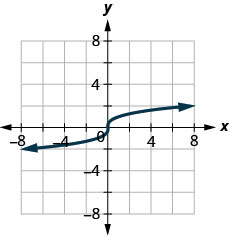
Figure 10.E.3
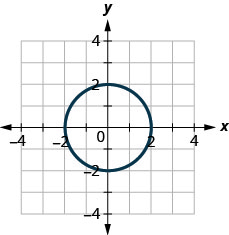
Figure 10.E.4
- Answer
-
1.
- Function; not one-to-one
- Not a function
In the following exercise, find the inverse of the function. Determine the domain and range of the inverse function.
- {(−3,10),(−2,5),(−1,2),(0,1)}
- Answer
-
1. Inverse function: {(10,−3),(5,−2),(2,−1),(1,0)}. Domain: {1,2,5,10}. Range: {−3,−2,−1,0}.
In the following exercise, graph the inverse of the one-to-one function shown.
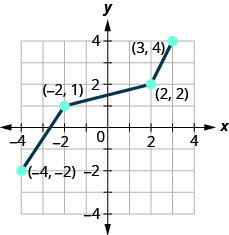
- Answer
-
Solve on your own
In the following exercises, verify that the functions are inverse functions.
- f(x)=3x+7 and g(x)=x−73
- f(x)=2x+9 and g(x)=x+92
- Answer
-
1. g(f(x))=x, and f(g(x))=x, so they are inverses.
- f(x)=6x−11
- f(x)=x3+13
- f(x)=1x+5
- f(x)=5√x−1
- Answer
-
1. f−1(x)=x+116
3. f−1(x)=1x−5
Evaluate and Graph Exponential Functions
In the following exercises, graph each of the following functions.
- f(x)=4x
- f(x)=(15)x
- g(x)=(0.75)x
- g(x)=3x+2
- f(x)=(2.3)x−3
- f(x)=ex+5
- f(x)=−ex
- Answer
-
1.
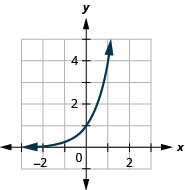
Figure 10.E.6 3.
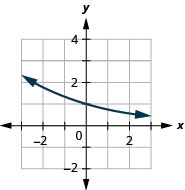
Figure 10.E.7 5.
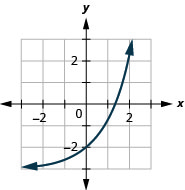
Figure 10.E.8 7.
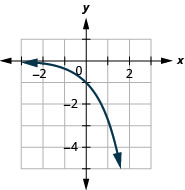
Figure 10.E.9
In the following exercises, solve each equation.
- 35x−6=81
- 2x2=16
- 9x=27
- 5x2+2x=15
- e4x⋅e7=e19
- ex2e15=e2x
- Answer
-
2. x=−2,x=2
4. x=−1
6. x=−3,x=5
In the following exercises, solve.
- Felix invested $12,000 in a savings account. If the interest rate is 4% how much will be in the account in 12 years by each method of compounding?
- compound quarterly
- compound monthly
- compound continuously
- Sayed deposits $20,000 in an investment account. What will be the value of his investment in 30 years if the investment is earning 7% per year and is compounded continuously?
- A researcher at the Center for Disease Control and Prevention is studying the growth of a bacteria. She starts her experiment with 150 of the bacteria that grows at a rate of 15% per hour. She will check on the bacteria every 24 hours. How many bacteria will he find in 24 hours?
- In the last five years the population of the United States has grown at a rate of 0.7% per year to about 318,900,000. If this rate continues, what will be the population in 5 more years?
- Answer
-
2. $163,323.40
4. 330,259,000
Evaluate and Graph Logarithmic Functions
In the following exercises, convert from exponential to logarithmic form.
- 54=625
- 10−3=11,000
- 6315=5√63
- ey=16
- Answer
-
2. log11,000=−3
4. ln16=y
In the following exercises, convert each logarithmic equation to exponential form.
- 7=log2128
- 5=log100,000
- 4=lnx
- Answer
-
2. 100000=105
In the following exercises, solve for x.
- logx125=3
- log7x=−2
- log12116=x
- Answer
-
1. x=5
3. x=4
In the following exercises, find the exact value of each logarithm without using a calculator.
- log232
- log81
- log319
- Answer
-
2. 0
In the following exercises, graph each logarithmic function.
- y=log5x
- y=log14x
- y=log0.8x
- Answer
-
1.
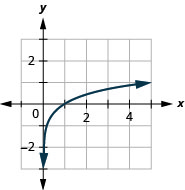
Figure 10.E.10 3.
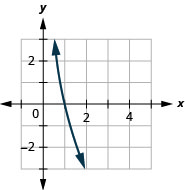
Figure 10.E.11
In the following exercises, solve each logarithmic equation.
- loga36=5
- lnx=−3
- log2(5x−7)=3
- lne3x=24
- log(x2−21)=2
- Answer
-
2. x=e−3
4. x=8
What is the decibel level of a train whistle with intensity 10−3 watts per square inch?
- Answer
-
90 dB
Use the Properties of Logarithms
In the following exercises, use the properties of logarithms to evaluate.
-
- log71
- log1212
-
- 5log513
- log33−9
-
- 10log√5
- log10−3
-
- eln8
- lne5
- Answer
-
2.
- 13
- −9
4.
- 8
- 5
In the following exercises, use the Product Property of Logarithms to write each logarithm as a sum of logarithms. Simplify if possible.
- log4(64xy)
- log10,000m
- Answer
-
2. 4+logm
In the following exercises, use the Quotient Property of Logarithms to write each logarithm as a sum of logarithms. Simplify, if possible.
- log749y
- lne52
- Answer
-
2. 5−ln2
In the following exercises, use the Power Property of Logarithms to expand each logarithm. Simplify, if possible.
- logx−9
- log47√z
- Answer
-
2. 17log4z
In the following exercises, use properties of logarithms to write each logarithm as a sum of logarithms. Simplify if possible.
- log3(√4x7y8)
- log58a2b6cd3
- ln√3x2−y2z4
- log63√7x26y3z5
- Answer
-
2. log58+2log5a+6log5b+log5c−3log5d
4. 13(log67+2log6x−1−3log6y−5log6z)
In the following exercises, use the Properties of Logarithms to condense the logarithm. Simplify if possible.
- log256−log27
- 3log3x+7log3y
- log5(x2−16)−2log5(x+4)
- 14logy−2log(y−3)
- Answer
-
2. log3x3y7
4. log4√y(y−3)2
In the following exercises, rounding to three decimal places, approximate each logarithm.
- log597
- log√316
- Answer
-
2. 5.047
Solve Exponential and Logarithmic Equations
In the following exercises, solve for x.
- 3log5x=log5216
- log2x+log2(x−2)=3
- log(x−1)−log(3x+5)=−logx
- log4(x−2)+log4(x+5)=log48
- ln(3x−2)=ln(x+4)+ln2
- Answer
-
2. x=4
4. x=3
In the following exercises, solve each exponential equation. Find the exact answer and then approximate it to three decimal places.
- 2x=101
- ex=23
- (13)x=7
- 7ex+3=28
- ex−4+8=23
- Answer
-
1. x=log101log2≈6.658
3. x=log7log13≈−1.771
5. x=ln15+4≈6.708
- Jerome invests $18,000 at age 17. He hopes the investments will be worth $30,000 when he turns 26. If the interest compounds continuously, approximately what rate of growth will he need to achieve his goal? Is that a reasonable expectation?
- Elise invests $4500 in an account that compounds interest monthly and earns 6%.How long will it take for her money to double?
- Researchers recorded that a certain bacteria population grew from 100 to 300 in 8 hours. At this rate of growth, how many bacteria will there be in 24 hours?
- Mouse populations can double in 8 months (A=2A0). How long will it take for a mouse population to triple?
- The half-life of radioactive iodine is 60 days. How much of a 50 mg sample will be left in 40 days?
- Answer
-
2. 11.6 years
4. 12.7 months
Practice Test
- For the functions, f(x)=6x+1 and g(x)=8x−3, find
- (f∘g)(x)
- (g∘f)(x)
- (f⋅g)(x)
- Determine if the following set of ordered pairs represents a function and if so, is the function one-to-one. {(−2,2),(−1,−3),(0,1),(1,−2),(2,−3)}
- Determine whether each graph is the graph of a function and if so, is it one-to-one.
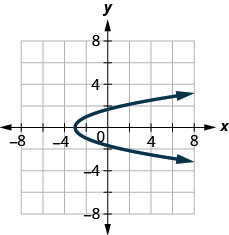
Figure 10.E.12
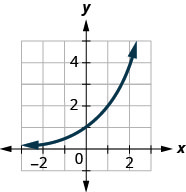
Figure 10.E.13
- Graph, on the same coordinate system, the inverse of the one-to-one function shown.
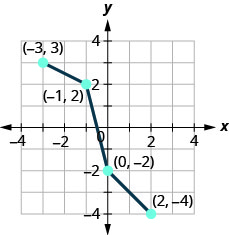
5. Find the inverse of the function f(x)=x5−9.
6. Graph the function g(x)=2x−3.
7. Solve the equation 22x−4=64.
8. Solve the equation ex2e4=e3x.
9. Megan invested $21,000 in a savings account. If the interest rate is 5%, how much will be in the account in 8 years by each method of compounding?
- compound quarterly
- compound monthly
- compound continuously
10. Convert the equation from exponential to logarithmic form: 10−2=1100.
11. Convert the equation from logarithmic equation to exponential form: 3=log7343.
12. Solve for x: log5x=−3
13. Evaluate log 111.
14. Evaluate log4164.
15. Graph the function y=log3x.
16. Solve for x: log(x2−39)=1
17. What is the decibel level of a small fan with intensity 10−8 watts per square inch?
18. Evaluate each.
- 6log617
- log99−3
- Answer
-
1.
- 48x−17
- 48x+5
- 48x2−10x−3
3.
- Not a function
- One-to-one function
5. f−1(x)=5√x+9
7. x=5
9.
- $31,250.74
- $31,302.29
- $31,328.32
11. 343=73
13. 0
15.
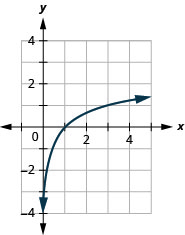
Figure 10.E.15 17. 40 dB
In the following exercises, use properties of logarithms to write each expression as a sum of logarithms, simplifying if possible.
- log525ab
- lne128
- log24√5x316y2z7
- Answer
-
1. 2+log5a+log5b
3. 14(log25+3log2x−4−2log2y−7log2z)
In the following exercises, use the Properties of Logarithms to condense the logarithm, simplifying if possible.
- 5log4x+3log4y
- 16logx−3log(x+5)
- Rounding to three decimal places, approximate log473.
- Solve for x: log7(x+2)+log7(x−3)=log724
- Answer
-
2. log6√x(x+5)3
4. x=6
In the following exercises, solve each exponential equation. Find the exact answer and then approximate it to three decimal places.
- (15)x=9
- 5ex−4=40
- Jacob invests $14,000 in an account that compounds interest quarterly and earns 4%. How long will it take for his money to double?
- Researchers recorded that a certain bacteria population grew from 500 to 700 in 5 hours. At this rate of growth, how many bacteria will there be in 20 hours?
- A certain beetle population can double in 3 months (A=2A0). How long will it take for that beetle population to triple?
- Answer
-
2. x=ln8+4≈6.079
4. 1,921 bacteria


